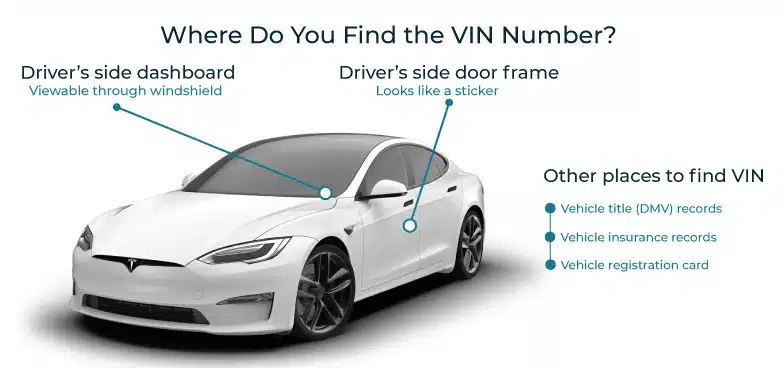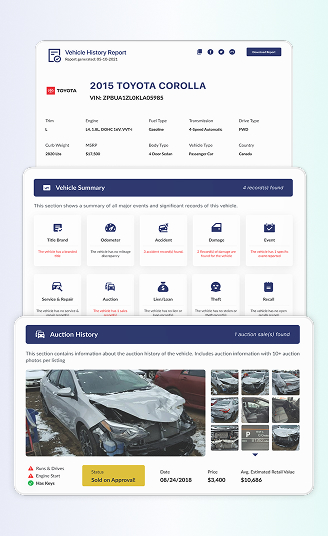Minnesota License Plate Lookup
With motor vehicle thefts rising 19% in Minnesota, it’s crucial to check a used car’s history before you buy to avoid buying a stolen vehicle.
Use our Minnesota license plate lookup tool to get the vehicle report to help you spot red flags before buying a used vehicle.
Table of Contents
What is Minnesota License Plate Lookup?
A Minnesota License Plate Lookup is a service you can use to look up a license plate and get the necessary information about the vehicle before buying. On the report, you will see important information that wasn’t disclosed by the seller, like accident records, recalls check, past owner’s history, and even a stolen report too.
Can You Look Up a License Plate for Free in Minnesota?
Yes, you can look up a Minnesota license plate for free. Our license plate lookup tool provides essential vehicle details, including:
- Associated VIN number
- Year, Make, and Model
- Country of Origin
- Market Value
- Transmission Type
- Fuel Type
- Drive Type
- Body Type
- Trim Information
- MSRP
- Engine Specifications
- Dimensions
- VIN
- Engine Value
- MSRP
- Manufacturer
- Fuel Type
- Body Type
- Year & Model
- Transmission
- Vehicle Type
- Sales Record
- Drive Type
- Mileage
- Market Value
- Doors
- Country of Origin
What Can You Get from a Minnesota License Plate Lookup?
License plate history reports provide in-depth knowledge about a vehicle. Here’s what you can uncover:
Vehicle Specification
Get the details about the car’s make, model, trim, engine configuration, fuel type, country of origin, drive type, body type, and more. See this section and ensure it matches your needs.
Ownership History:
Discover how many times the car has changed hands. See the location, ownership duration, and the location of the vehicle.
Accident Reports
See the location, the date, and how many times the vehicle was involved in accidents. For additional information, you can also check if the car was damaged after the accident.
Sales Records:
Understand the car’s transaction history, including dates and prices. It gives insight into its value trends and whether it’s been flipped frequently.
Mileage Records:
Consistent records help confirm the car’s actual mileage and prevent fraud, such as odometer rollback scams. Check the date and recorded mileage, and the last recorded mileage of the vehicle.
Auction History and Photos:
See if the car has been sold at auctions. Check the price, the location, and get up to ten pictures that show the vehicle’s condition during the auction.
Lien/Loan Records:
Check for unpaid loans tied to the car. This ensures the vehicle is free of financial encumbrances before purchasing.
Title Information:
Confirm the car titles, whether it has a clean, salvage, or rebuilt title. A clean title indicates fewer risks and fewer potential legal complications.
Theft Records:
Avoid legal trouble and unexpected repossession by confirming its theft-free status. See the date, location, and data source of the information.
Warranty Coverage
Be informed of the warranty coverage of the vehicle. Check the months and mileage limitation of the warranty, and what kind of coverage it has, e.g., basic warranty, corrosion protection, and roadside assistance.
Service and Maintenance History:
Review repair logs and maintenance schedules. A well-maintained car is less likely to have major mechanical issues in the future.
Recall Information:
Discover open or past recalls affecting the car. See the date of recalls, what issues caused the recalls, and the steps taken by the manufacturer to fix the issues.
Why a Minnesota License Plate Lookup is Crucial For Car Buyers and Sellers?
A Minnesota license plate lookup helps buyers and sellers make informed decisions. Here’s why it matters:
- Avoid Scams: Odometer rollback scams make cars seem less used. Buyers can avoid overpaying for vehicles with hidden damage or undisclosed salvage titles. Sellers, meanwhile, can prove their vehicle’s authenticity and legitimacy, gaining buyer trust.
- Ensure Safety: Accident and recall records provide essential details about a car’s safety status. For example, if a car was involved in a serious collision, you can confirm whether critical repairs, such as airbag replacements, were completed. Sellers can highlight a clean accident history or address safety concerns, ensuring confidence during the sale.
- Determine Fair Value: Market value estimation is crucial for pricing negotiations. A license plate lookup shows whether a vehicle is fairly priced based on condition and history. For buyers, this prevents overpaying for overpriced cars. Sellers can justify higher asking prices by showcasing clean titles, low mileage, or documented maintenance history.
- Check Legal Ownership: A license plate lookup uncovers liens or loans tied to a car. For example, purchasing a vehicle with an unpaid loan could result in repossession. Buyers benefit by confirming the car’s legal ownership status, while sellers ensure no legal hurdles arise during the sale.
- Assess Vehicle Reliability: Maintenance and service history records reveal how well a car has been cared for over its lifetime. For instance, consistent oil changes and part replacements suggest a reliable car. Buyers can avoid vehicles with irregular or missing service records, while sellers can highlight a car’s well-maintained condition to attract serious buyers.
- Support Negotiations: A history report gives buyers leverage to negotiate lower prices for cars with accidents or high mileage. For sellers, a clean record or rare specifications can support their asking price.
How to Lookup a Minnesota License Plate Number?
Looking up a Minnesota license plate is easy; you just need to fill in the form above. Here are some simple steps to guide you through the process.
Enter the License Plate Number
Find the plate number on the front or back of the vehicle. Enter it into the form above and click “Search License Plate”.
Review and Purchase
Preview the vehicle details and proceed to payment to get the full report.
Get Your Report
Download the vehicle history report in a printable PDF format.
Why Vehicle History Report Important? A Real Case?
Seller’s Claim
- Has no issues
- Properly maintained
- Privately used
- The price is the same as that of the other sellers ‘
Actual Condition
- The vehicle title has a salvage brand record
- 1 accident record
- 2 Record(s) of damage
- 3 specific events reported
- 11 service & repair record
- 1 auction record
- 1 lien or loan records
Outcome
- The buyer cancels the buying process
- The car is no longer safe to drive because it has too many red flags
Why Checking the License Plate is a MUST
- Check the VIN before you decide to buy a used vehicle, especially from a private seller
- Make sure to know everything before proceeding to buy.
Minnesota Laws/Legislation on License Plates
Minnesota has specific rules regarding license plate display, renewal, and issuance. These laws ensure proper vehicle identification, road safety, and compliance with state requirements. Below is an overview of the key regulations:
Front and Rear Plates
Most vehicles must display both front and rear license plates.
Single Plate Exceptions
Motorcycles, trailers, and some trucks are only required to display one plate, usually on the rear.
Issuing Authority
License plates are provided and regulated by the Minnesota Department of Public Safety (DPS).
Renewals and Tabs
Plates must be renewed annually, and updated expiration tabs should be visible at all times.
Custom and Specialty Plates
Available for an additional fee, these include personalized, organizational, and special design plates. For detailed regulations, visit the Minnesota DPS website.
Minnesota License Plate Design and Format

Regular license plates in Minnesota have six letters or numbers. Special or custom plates can look different and might have 2 to 7 letters or numbers. Standard plates usually have blue writing on a shiny white background.
Types of License Plates in Minnesota
Minnesota has a few different types of license plates that its residents can choose from: standard plates, personalized plates, veteran plates, disability plates, collector and classic car plates, temporary plates, and specialty plates.
Here is the quick explanation of what each plate is intended for and how and where to get them.
Standard Plates
These are the default plates issued to most passenger vehicles in Minnesota. They include a standard design, registration number, and expiration stickers.
Standard plates are the most common and are automatically provided when a vehicle is first registered or when old plates are replaced.
Personalized Plates
Minnesota drivers can apply for personalized plates with a custom combination of letters and numbers. These plates allow individuals to showcase names, slogans, or unique messages.
Requests must be approved by the Minnesota Driver and Vehicle Services (DVS) and cannot include offensive or inappropriate language.
Veteran Plates
Veteran license plates honor military service members, veterans, and sometimes their families. Different designs exist for each branch of the armed forces, as well as for specific conflicts or awards.
These plates often require proof of service or eligibility when applying through the Minnesota DVS.
Disability Plates
Disability plates are issued to drivers with qualifying medical conditions that limit mobility. These plates allow access to designated parking spaces and include the international wheelchair symbol.
To obtain disability plates in Minnesota, applicants must provide certification from a licensed healthcare professional confirming their eligibility.
Collector and Classic Car Plates
Minnesota offers special plates for collector vehicles and classic cars. These are typically available for vehicles over 20 years old or those deemed rare and historically significant. Owners must meet specific criteria and may face restrictions on how often the vehicle can be driven.
Temporary Plates
Temporary plates provide legal vehicle operation while waiting for permanent registration. Dealers often issue them after a vehicle purchase, valid for a limited period.
Temporary tags in Minnesota are usually displayed in the rear window and must remain visible until official plates are received.
Specialty Plates
Specialty plates support organizations, charities, universities, and causes such as wildlife preservation or public service recognition. These plates feature unique designs and often require an extra fee.
Minnesota’s specialty plates not only personalize a vehicle but also help raise funds for the programs they represent.
In Minnesota, standard license plates remain with the vehicle when it is sold. However, specialty and personalized plates may be transferred to a different vehicle. New residents bringing vehicles from another state are also required to transfer their registration and apply for Minnesota plates within 60 days of residency.
Transferring License Plates in Minnesota
In Minnesota, standard license plates remain with the vehicle when it is sold. However, specialty and personalized plates may be transferred to a different vehicle. New residents bringing vehicles from another state are also required to transfer their registration and apply for Minnesota plates within 60 days of residency.
Transferring Specialty or Personalized Plates to a New Vehicle
If you want to keep your unique plate when changing vehicles, you must:
- Complete the Special Plate Application.
- Visit a Deputy Registrar’s Office.
- Pay the required transfer fee.
- Receive your new plates for the updated vehicle.
Transferring Out-of-State Plates to Minnesota
New residents moving to Minnesota must register their vehicles locally. The process requires:
- Gathering documents, including:
- Proof of insurance (company, policy number, expiration date).
- Driver’s license or state-issued ID.
- Current odometer reading.
- If applicable, lender details (name, address, loan date).
- Completing the application to title/register a vehicle.
- Visiting a Deputy Registrar’s Office.
- Paying the necessary fees.
- Receiving Minnesota plates and tabs.
How to Register and Transfer a Car Title in Minnesota?
- Complete the PS2000 form.
- Sign over the vehicle from the original owner to yourself.
- Visit the Minnesota Driver Vehicle Services (DVS)
Other Vehicle Check Tools
VIN Decoder
Window Sticker Lookup
Build Sheet by VIN
Classic Car History Report
Why Choose Detailed Vehicle History for a License Plate Lookup in Minnesota?
Detailed Vehicle History provides a fast and reliable way to run a Minnesota license plate lookup.
With a Minnesota license plate lookup, you can access:
Title and ownership history: Verify past owners and confirm the vehicle’s legitimacy.
Accident and damage records: Spot any major incidents or hidden issues.
Additional details: Market value, recalls, theft records, and more.
License Plate Lookup By States
FAQs About License Plate Lookup in Minnesota
Q. How do I Look up a License Plate Number in Minnesota?
A. Enter the MN plate number into our lookup tool to access the vehicle history report and information. When buying a used car in Minnesota, and you don’t have the vehicle VIN, easily look up the license plate number to make an informed decision.
Q. Can I perform a DMV License Plate lookup Without Visiting my Local DMV Office?
A. Yes. Our Minnesota license plate search tool can relieve the stress of visiting the DMV office. Enter the license plate number to access records such as ownership history, recalls, theft records, title status, and more.
Q. How do I Find the Owner of a Minnesota License Plate?
If you provide tenable reasons to the Vehicle and Driver Services, you may be granted legal access to find a license plate owner in Minnesota. This ensures compliance with the DPPA and the state’s non-disclosure policies.
Q.Is a free Minnesota License Plate Lookup Legal?
Yes, definitely. Our tool allows you to conduct a free license plate number check in compliance with state laws. However, to access sensitive information, such as the owner’s name, you must obtain legal authorization or written consent from the vehicle owner.


